A Mosque in Sikh architecture
By Parvez Mahmood
The Friday times: 16 Jun 2017
Parvez Mahmood on the contested past of the Sunehri Mosque in Lahore, and its place in the Walled City today
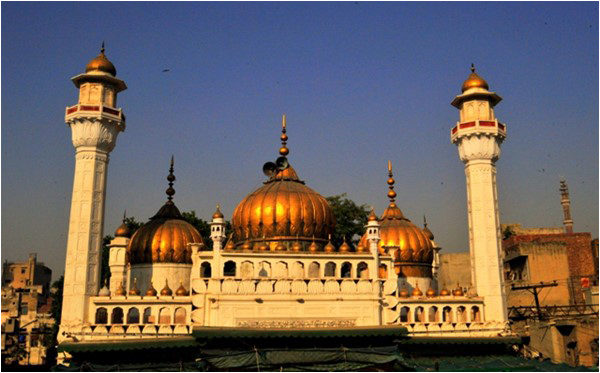
Growing up in the Gumti Bazaar area of the Walled City of Lahore, I would often pass by this exquisite mosque that stands where Dabbi and Kaisara Bazaars merge with Kashmiri Bazaar. It has three main domes; a larger one in the middle and two smaller ones on the sides. It has smaller domelets on top of its two tall and four short minarets. It also has a long row of nine – flanked by two shorter rows of six each – small decorative domelets on top of the fore wall of the main prayer chamber. All these domes and domelets are golden in colour. In addition, all these domes have decorative golden petals at their bases. It was intriguing to me at that tender age that the only other structure in the City built in a similar style and golden colours is the memorial complex of Guru Arjun Dev and Raja Ranjit Singh, adjacent to the Shahi Mosque that I often used to frequent.
Having become wiser, I now know that the gilded domes, the petals and domelets are part of Gurdawara rather than Mosque architecture. A mosque in Sikh style, therefore, has a special historic meaning, indicating a syncretised past at a chaotic time of Indian history. It is also significant that the colour has survived the increasingly extremist tendencies of post 1971 Pakistan. Because of this abundance of golden colour, the mosque is appropriately known as Sunehri Mosque.

A banyan tree
The Hindus and the Sikh community, who controlled the bulk of business in the surrounding bazaars, were against the construction of the mosque
The mosque is adjacent to an even older landmark known as Baoli garden. ‘Baoli’ refers to awater well with a stair case descending down to the water level. There are several hypotheses regarding its origin suggesting that the well was constructed around 1600 AD. It was a religiously sacred place for the majority Hindus and the Sikh community, who controlled the bulk of business in the surrounding bazaars and were against the construction of the mosque.
The Baoli Bagh and the Sunehri Mosque are historically inseparable. The local Sikh and Hindu community was opposed to the construction of the mosque on religious as well as secular grounds. The pious – or is it the mischievous – among them thought that the venerated Baoli might be ‘desecrated’ and religious ceremonies disturbed, whereas the traders thought “it would obstruct the traffic,” because the then vacant plot provided breathing space to a congested commercial centre. That is strange because I have seen some images of the area dating from the early 1900s that show the streets to be deserted. In 1748, there would hardly be a few persons on these roads.
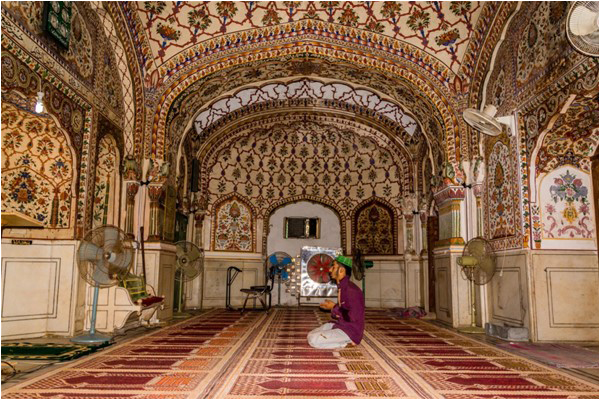
The Prayer Hall
The powerful builder, Nawab Bukhari Khan, the governor of Lahore, had to obtain a fatwa from the Muslim clergy to subdue the religious resistance. He overcame the secular opposition by constructing the Mosque on an eleven-feet-high plinth that allowed for many shops on the ground level under the mosque, on all its sides, leaving only a small portion for the staircase. The rent from the shops was to pay for the upkeep of the Mosque. The shops still exist today.
The Mosque is the last structure that can be termed ‘Mughal’ because at the time of its construction, the ruler in Delhi was still a direct descendant of Emperor Babur and the governor in Lahore recognised his suzerainty over his domains. In reality though, due to incessant wars of succession and Persian and Afghan incursions, the Mughal hold by then had become very tenuous. In the Punjab, the Sikhs, despite severe atrocities committed against them, had become resurgent and their various armed bands – Misls – were in the process of carving out their respective areas of influence.
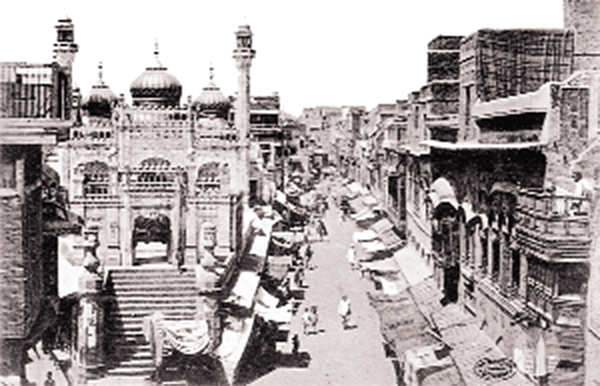
Sunehri Mosque and Kashmiri Bazaar in the early 20th century
The construction of the Mosque started in 1748 and was completed in 1753. There was chaos in Punjab, Sindh and beyond the Indus in the wake of the sack of Delhi by Nader Shah in 1739, followed by seven successive invasions between 1748 and 1767 by the hordes of Ahmad Shah Abdali. Initially, the Mughal governor of Punjab, Moin-ul-Mulk aka Mir Mannu, fought against Abdalis but correctly assessing the Afghan strength against the weakened Mughals, he decided to join the former. Abdali appointed him as his governor over Lahore and he retained the post till his death in 1753. When the construction of the mosque was in the final stages, the two fought a war in 1752 over non-payment of annual tribute and Lahore was briefly occupied by Afghan troops.
Governor Mir Mannu was a sworn adversary of the Sikhs, who had started gaining strength in various parts of the province. During his rule, Sikhs were massacred mercilessly in thousands. He and Abdali twice destroyed Harmindar Sahib, holiest of Sikh shrines in Amritsar, filling the sacred pool with cow entrails. Sikhs to date remember them with an animosity that is reserved for few. However, the Sikh power continued to grow and they were to soon rule Punjab for about eight decades starting with the final departure of Abdali from the area in 1767. By 1783, they were holding court in the Diwan-i-Aam in Delhi and dictating terms to the nominal Mughal Emperor.
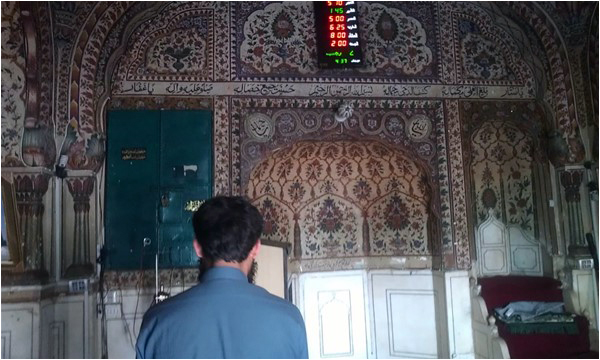
The mimbar (pulpit)
From 1767, the triumvirate of Lehna Singh Majithia, Gujjar Singh Banghi and Suba Singh ruled Lahore for thirty long years until the amalgamation of Punjab into a single empire by Ranjit Singh in 1799. Lehna Singh controlled the Walled City and the Fort. He converted the Sunehri Mosque to a Gurdawara and placed a copy of the Sikh holy book Granth Sahib in the prayer hall. The stated pretext for this imposition was that the call to prayers disturbed the Sikh ceremonies in the adjacent Baoli garden. The Mosque served as a Sikh worship place for nearly five decades.
Well into Ranjit Singh’s rule in 1820, his powerful foreign minister and trusted lieutenant Fakir Azizuddin pleaded with the Maharaja to restore the place to the Muslims. Ranjit relented on the condition that the volume of Azan – call for prayers – be kept low and that the Mosque was to forfeit the shop rentals. The Granth Sahib was consequently removed, Gurdawara was converted to a Mosque and the Muslims resumed their prayers.
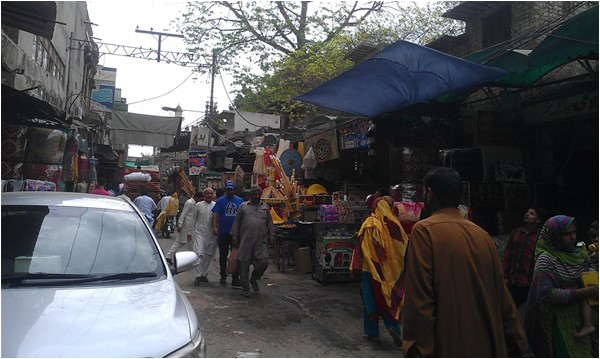
Kashmiri Bazaar today
The crude manner in which fans, lights and clocks are installed are a blemish on the delicate art work
The Mosque is small but has been lovingly decorated. It has exquisite intricately painted frescoes on the interior walls as well as the roof. I marveled at the tenacity of local Michelangelos who must have spent months upon months planning the artwork and then executing it, reclining face up on scaffoldings with their brushes in their hands. However, the elegance of frescos doesn’t match those of the neighbouring Begum Shahi and Wazir Khan Mosques. Certainly, the mayhem and bloodshed created by Abdali invasions and Sikh incursions prevented good artisans being available for long periods of time. With all the turmoil recorded in history books for the period, it is a wonder in itself that the Mosque saw its completion with its minarets, water pool and frescoed interiors. It is also significant that three mosques, all small and similar in area with the name of Sunehri, were constructed in the waning years of the Mughal Empire from 1721 to 1753; two in Delhi and one in Lahore, all having gilded domes. That in itself speaks volumes for the changing times.
During my recent excursion in the Bazaars of the area, I found that the trading community has ultimately won the day by hemming in the Baoli and Mosque structure with shops and street vendors of all creeds. At the bottom of the Mosque, there were some food stalls, selling chat, burgers and drinks. Their clients squat on mosque stairs, satisfying their stomachs and palates, oblivious to the memory of vainly protesting traders nearly three centuries ago.
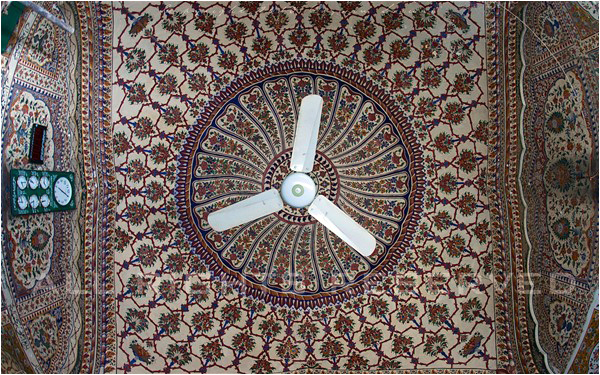
Frescoes on the roof and the walls
I went there at noon and climbed up the stairs to enter the Mosque but found its gate locked. Some children and ladies were sitting on the stairs, eating chat. An aged sympathetic shopkeeper from across the staircase called me over and enquired if I wanted to pray. I told him that I was a visitor and asked him the time for the mosque to open. He glanced at his cell phone. It was 12:15.
“It will open at 13:15 for the Zuhar – midday – prayers.” He informed me.
I looked at the gate helplessly. I had another appointment to make.
He yelled over to a young vendor at the foot of the staircase and asked him to open the mosque for me. He replied that Qazi Sabib – the mosque clerk – had not left the key with him that day.
“Or has he told you not to let anyone in during his absence?” the old man was sarcastic.
The young man smiled away, making a fresh plate of spicy fruit salad for a waiting client.
“Qazi sahib comes for the prayers only. In between he is away on his errands,” the old man informed me knowingly. I wondered who announces the Azan call for prayers.
I learnt that the Mosque Imam goes off for his own errands or business, which made sense in this centre of wholesale markets for gold jewelry, electric goods, hosiery items, kitchen utensils, artificial jewelry, bridal wear, cloth, children toys and a host of other things. Traders from all over Punjab come here for bulk purchases. I decided to take a look at the nearby Wazir Khan Mosque and wait for the Qazi sahib to come back.
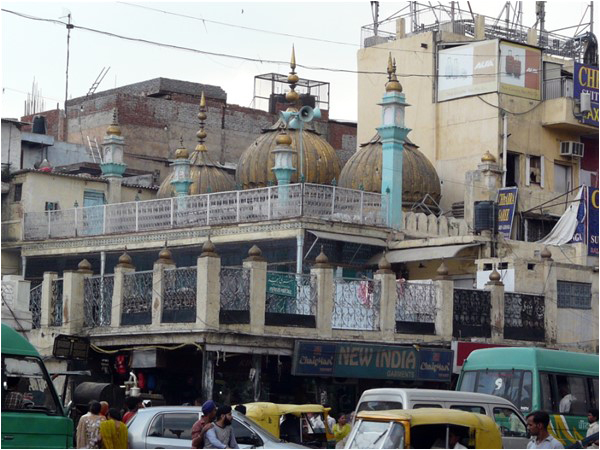
The other Sunehri Mosque, Delhi
I recalled the time when its builder had to face hostility of local traders. Now, however, the traders have not only encroached upon all around the mosque but are also managing and running it. I only wish that the traders of 250 years ago, who were mindful of the traffic, were around to witness the amazingly overloaded vehicles and motorcycles squeeze through the bustling narrow lanes around Kashmiri Bazaar.
The Baoli has survived the intense proliferation of commercial activities around its perimeter though its well has filled up without leaving a visible trace. The garden is bounded on three sides by rows of shops. Its eastern boundary wall divides it from the Sunehri Mosque.
The Bagh has a narrow – under three feet wide – passage from across the Soha Bazaar and constitutes its sole entrance. On my recent visit to the area in Apr 2017, I saw about fifty motorcycles parked in the Bagh on its right half. Evidently, the park is slowly, China-cutting style, being converted to commercial use. I hope some political or administrative heavyweight of the area places a barrier in the passage to obstruct motorcycle entry into the historical edifice.
One hallmark of the Baoli garden is the banyan tree close to the wall that separates the garden from the mosque. In the days gone by, religious ceremonies at the Baoli by the local trading community caused confiscation of the Mosque by the ruling Sikhs. Now the tree has been Islamised. I noticed a religious sign of a different kind; one that I don’t recall from the time that I lived in the area in 1960s, as testified by some of the older images of the garden. It is a fairly big sized signboard featuring the Holy Kaa’ba, hanging smack right in the middle of the graceful tree. It must have been the result of Zia-inspired Islamic zeal that has tragically permeated our social fabric. Considering the history of the garden, addition of a few saffron garlands would have appeared appropriate.
I have now witnessed the dilapidated condition of many of the Auqaf-owned historic mosques. The crude manner in which fans, lights and clocks are installed are a blemish on the delicate art work. Electric lines run haphazardly along walls. In contrast, all the private mosques and mausoleums that are run on public donation are in immaculate condition. I wonder if it is practical to transfer the historic sites to selected private organisations or institutions. I am not certain what would be the mechanism but the bureaucrats can formulate a mutually beneficial workable agreement where the building and its character is not compromised. One thing that the Auqaf administration can at least do is to find a more aesthetic alternative for anchoring the quartet of loudspeakers rather than tying them crudely on top of the main dome.
Like all heritage places under the Auqaf department, this Mosque had also fallen into disrepair. During one of my earlier visits, I saw it in a really dilapidated state. Then in 2011, the US Consulate donated a grant of $60,000 for the conservation and restoration of the mosque under the US Ambassador’s Cultural Heritage Fund. The restoration work on the three large domes (with expensive gold paper), domelets, floor, roof, doors, frescoes and minarets has been completed. The place looks much cleaner, brighter and prettier.
I was glad to have visited it yet one more time.
Parvez Mahmood retired as a Group Captain from PAF and is now a software engineer. He lives in Islamabad and can be reached at parvezmahmood53@gmail.com